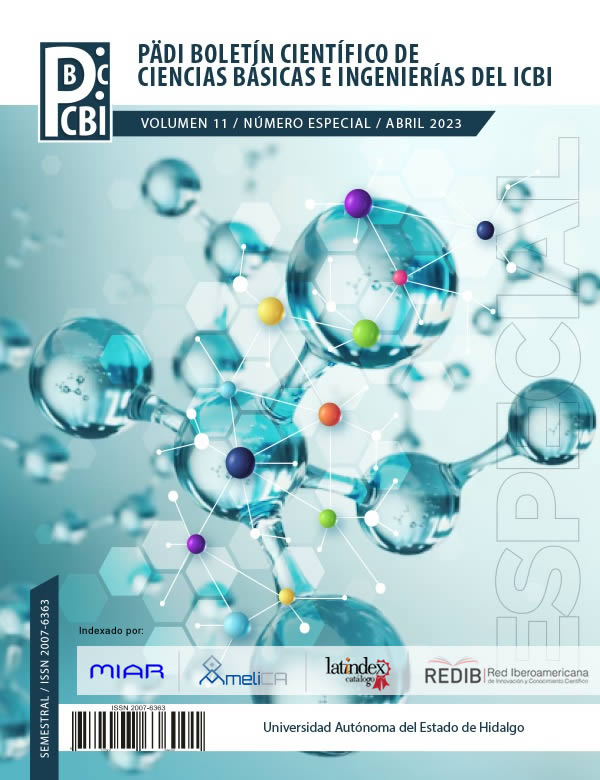Acetaminophen-DNA nitrogenous bases interaction, an electrochemical study
Abstract
The interaction of acetaminophen with the purine bases of DNA (guanine and adenine) is exposed for the first time. The study of the interaction was carried out through differential pulse voltammetry (VDP), there are not interference between acetaminophen, guanine (G) and adenine (A), so they can be analysed independently. The effect of the drug concentration was analysed from current and potential changes, as indicative of possible alterations in the bases, a significant decrease in the current of G and A was observed. In addition, interaction with oxidation product of acetaminophen, N-acetyl-para-benzoquinoneimine, was analysed through production in situ by electrodeposition of the oxidized species of the drug. the results show a damage on G and A induced by the exposure to the product of oxidative degradation, where the most affected base is adenine.
Downloads
References
Bard, A. & Faulkner, L., (2004) Electrochemical Methods Fundamentals and Application. 2nd ed. New York: Wiley.
Bermúdez, R., Quesada Vargas, M., Esquivel Rodríguez, N. (2019). Intoxicación por acetaminofén: diagnóstico y abordaje en el adulto. Revista Médica Sinergia, 4, e257.
DOI: 10.31434/rms.v4i7.257
De la Cruz Morales, K., Alarcón-Angeles, G., Merkoçi, A., (2019). Nanomaterial-based Sensors for the Study of DNA Interaction with Drugs 31, 1845-1867.
DOI: 10.1002/elan.201900286
Jaeschke, H., McGill, M. R., Ramachandran, A., (2012). Oxidant stress, mitochondria, and cell death mechanisms in drug-induced liver injury: lessons learned from acetaminophen hepatotoxicity. Drug metabolism reviews, 44, 88–106.
DOI: 10.3109/03602532.2011.602688
Hassani Moghadam, F., Taher, M.A., Karimi-Maleh, H., (2021). Doxorubicin Anticancer Drug Monitoring by ds-DNA-Based Electrochemical Biosensor in Clinical Samples. Micromachines 12, 808.
DOI:10.3390/mi12070808
Hasanzadeh, M., Shadjou, N., (2016). Pharmacogenomic Study Using Bio- and Nanobioelectrochemistry: Drug–DNA Interaction. Materials Science and Engineering: C, 61, 1002–1017.
DOI: 10.1016/j.msec.2015.12.020
McGill, H., Ramachandran, A. (2012). Oxidant stress, mitochondria, and cell death mechanisms in drug-induced liver injury: lessons learned from acetaminophen hepatotoxicity. Drug metabolism reviews, 44(1), 88–106 DOI:10.3109/03602532.2011.602688
Oliveira-Brett, A.M., Diculescu V., Piedade, J.A.P., (2002). Electrochemical oxidation mechanism of guanine and adenine using a glassy carbon microelectrode Bioelectrochemistry 55, 61-62.
DOI: 10.1016/S1567-5394(01)00147-5
Oliveira-Brett, A.M., Diculescu V., (2004). Electrochemical study of quercetin–DNA interactions: Part II. In situ sensing with DNA biosensors. Bioelectrochemistry 64, 143-150.
DOI: 10.1016/j.bioelechem.2004.05.002
Phillips, D. H., & Arlt, V. M., (2009). Genotoxicity: damage to DNA and its consequences. In A. Luch (Ed.), Molecular, Clinical and Environmental Toxicology. 1, 87-110.
DOI: 10.1007/978-3-7643-8336-7_4
Rehman, S.U., Sarwar, T., Husain, M.A., Ishqi, H.M., Tabish, M., (2015) Studying Non-Covalent Drug–DNA Interactions. Archives of Biochemistry and Biophysics, 576, 49–60.
DOI: 10.1016/j.abb.2015.03.024
Salehzadeh, H., (2020) Tunable oxidative release of N-acetyl-p-benzoquinone-imine and acetamide from electrochemically derived sub-monolayer acetaminophen modified glassy carbon electrode, Journal of Electroanalytical Chemistry 880:1572-6657.
DOI: 10.1016/j.jelechem.2020.114845.
Copyright (c) 2023 María Guadalupe Valencia-Valencia, Georgina Alarcón-Ángeles, María Teresa Ramírez-Silva, Martín Gómez-Hernández, Marcela Hurtado-Y-de-la-Peña

This work is licensed under a Creative Commons Attribution-NonCommercial-NoDerivatives 4.0 International License.













